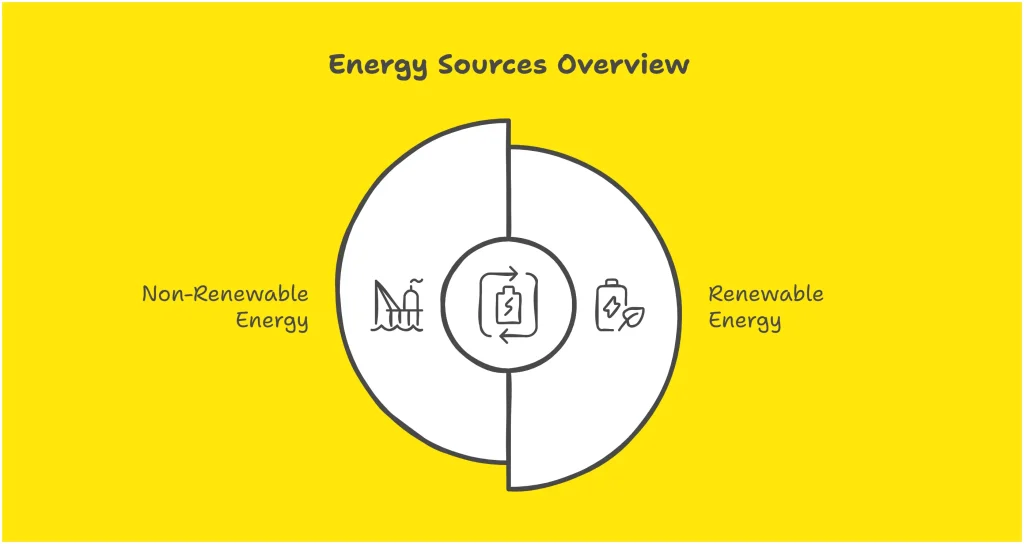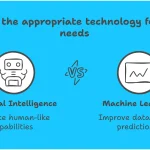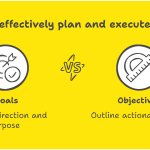Thomas Edison once said, I’d put my money on the sun and solar energy. What a source of power! This quote starts our journey into renewable and non renewable energy. It’s key to our planet’s energy and keeping it green.
Renewable and non renewable energy are two big ideas in energy. Renewable energy, like solar and wind, is always coming back. It’s good for our planet.

But, non-renewable energy, like fossil fuels, is running out. It also harms our environment. Knowing the difference helps us choose better for our future.
Understanding Energy Sources: A Basic Overview
Energy is key to our modern lives. It powers our homes, industries, and cars. We need to know the difference between renewable and non-renewable energy. Both are important for our energy needs.
Renewable energy, like solar and wind, is made naturally. It’s better for the planet than non-renewable energy, like fossil fuels. Non-renewable energy is running out and harms the environment more.
We need a mix of energy to have a green future. Knowing about energy sources helps us choose better. We should pick renewable energy more often.
We will look at renewable and non-renewable energy more. We’ll see how they affect our planet and wallets. Understanding these differences helps us choose a better energy path.
Also Learn: AI vs Machine Learning: Key Differences Explained
Key Characteristics of Renewable Energy Sources
Renewable energy is key as we move towards a greener future. It can be made again and again, making it a good choice for energy. Solar and wind power are cleaner than old energy sources, cutting down on bad air and harm to nature.
Renewable energy has many pluses, like using less oil, saving money, and giving us energy freedom. As tech gets better, renewable energy costs go down.
Renewable energy also cuts down on bad air, making our world cleaner. Here are some good things about it:
| Renewable Energy Source | Benefits |
|---|---|
| Solar Power | Zero emissions, low maintenance, energy independence |
| Wind Power | Reduced greenhouse gas emissions, low operating costs, reliable energy source |
| Hydro Power | Renewable, reliable, and clean source of energy, supports irrigation and drinking water |
In short, renewable energy is a clean and sustainable choice. It has many benefits, like less bad air and more energy freedom. It’s a big step towards a better future.
Common Types of Non-Renewable Energy Resources
Non-renewable energy is what we can’t make more of easily. It includes things like coal, oil, and natural gas. These have been our main energy sources for a long time. But, they harm our environment a lot.
Using these energy sources causes problems like climate change and pollution. Even so, many places keep using them. In 2020, about 84% of the world’s energy came from non-renewable sources, says the International Energy Agency.
Fossil Fuels Explained
Fossil fuels come from old plants and animals. They power our homes, cars, and more. But, getting and using them pollutes our air and water.
Nuclear Energy: A Special Case
Nuclear energy is made by splitting atoms. It’s cleaner than some other energy, but it has its own problems. Like how to safely get rid of radioactive waste.
Current Dependency on Non-Renewables
Many countries keep using non-renewable energy, even knowing the risks. Here’s how much non-renewable energy some countries use:
| Country | Non-Renewable Energy Sources |
|---|---|
| United States | 80% |
| China | 85% |
| India | 75% |
The Difference Between Renewable and Non Renewable Energy
It’s key to know the difference between renewable and non-renewable energy. Renewable energy, like solar and wind, is good for the planet. Non-renewable energy, like fossil fuels, harms the environment.
Choosing the right energy source matters. Renewable energy is better for our planet and can save money in the long run. But, it might cost more to start using it.
Resource Availability and Replenishment
Renewable energy never runs out because it’s made by nature. Non-renewable energy, like oil, will eventually disappear.
Environmental Impact Comparison
Renewable energy is kinder to our planet. It doesn’t pollute or cause climate change. Non-renewable energy, on the other hand, harms the environment.
Cost and Economic Factors
The cost of renewable energy is higher at first. But, it saves money and is better for the planet in the long run.
| Energy Source | Renewable/Non-Renewable | Environmental Impact | Cost |
|---|---|---|---|
| Solar Power | Renewable | Low | Medium |
| Wind Power | Renewable | Low | Medium |
| Fossil Fuels | Non-Renewable | High | Low |
Environmental Impact of Energy Choices
Choosing the right energy is key for a greener future. Renewable energy cuts down on harmful gases and pollution. This makes it a better choice than non-renewable energy, which harms our planet.
Studies show renewable energy can cut carbon emissions by up to 78%. This is a big win against the pollution from fossil fuels. Fossil fuels release harmful gases that hurt our climate and air.
But, renewable energy like solar and wind is much cleaner. They don’t pollute much. Plus, their costs are going down, making them a better deal than old energy sources. As we move to cleaner energy, our planet will thank us.
| Energy Source | Greenhouse Gas Emissions | Air Pollution |
|---|---|---|
| Fossil Fuels | High | High |
| Reneable Energy | Low | Low |
So, picking the right energy is vital for a greener tomorrow. By going for renewable energy, we can lessen our harm to the planet.
Economic Implications of Different Energy Sources
The cost of different energy sources is key to their use. As we move to greener options, knowing the costs is vital. Starting with renewable energy can be pricey, but it saves money in the long run and creates jobs.
Looking at solar, wind, and hydro power shows their economic value. The cost of these options goes down as technology improves. This makes them more affordable than old energy sources.
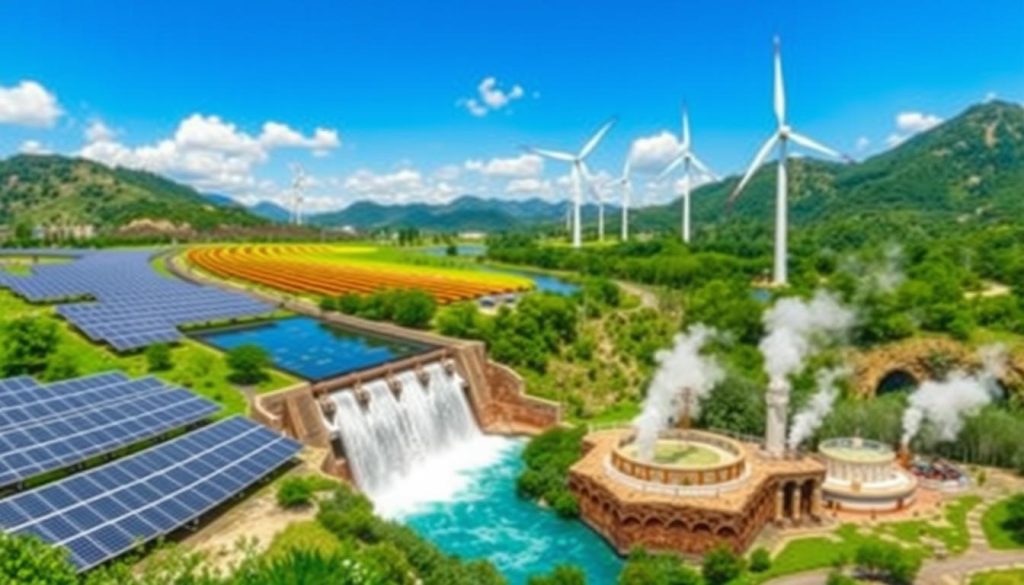
Switching to renewable energy will bring new jobs. These jobs will be in making, setting up, and fixing these systems. The shift to green energy has big economic benefits, and it’s important to understand these.
Initial Investment Requirements
Starting with renewable energy can cost a lot. But, it saves money over time and creates jobs. As costs drop, investing in green energy becomes more attractive.
Long-term Cost Analysis
Renewable energy is cheaper in the long run than old energy. The cost of starting and keeping it up is lower. This makes it a good choice for saving money.
Job Market Impact
The move to renewable energy will create many jobs. These jobs will be in making, setting up, and fixing green systems. As we go green, the job market and economy will change.
Technology and Innovation in Energy Production
Renewable energy is getting cleaner thanks to new tech. Solar panels and wind turbines work better now. For example, new solar panels can make 25% more energy.
New tech isn’t just for solar and wind. Hydrokinetic energy uses moving water too. Companies like Verdant Power are showing how it can power our homes and work places.
Using renewable energy is getting cheaper. Solar energy costs have dropped a lot in ten years. This makes it a better choice than fossil fuels.
| Renewable Energy Source | 2000 | 2010 | 2020 |
|---|---|---|---|
| Solar Energy | $0.36/kWh | $0.22/kWh | $0.06/kWh |
| Wind Energy | $0.08/kWh | $0.06/kWh | $0.04/kWh |
New tech is key for cleaner energy worldwide. It shows we need to keep innovating and investing in this area.
Global Energy Transition Trends
The world is changing how we make and use energy. We’re focusing more on clean energy. This change is to cut down on harmful emissions and fight climate change.
Countries want to meet their energy needs without harming the planet. So, using clean energy is key.
Solar and wind power are leading the way in clean energy. Governments and companies are spending a lot on these areas. This makes clean energy cheaper and more competitive with old energy sources.
This shift is good for our planet and creates new jobs. It also brings new ideas and growth.
Current Adoption Rates
More countries are using clean energy, setting big goals. The European Union wants 32% of its energy to be clean by 2030. China and India are also big investors in clean energy, helping the sector grow.
Future Projections
The future of clean energy looks bright. As technology gets better and costs drop, we’ll see more clean energy use. The International Energy Agency says clean energy will power 60% of the world by 2050.
This will greatly reduce harmful emissions.
Policy Influences
Government policies are key in the energy shift. They help clean energy compete with old energy. Things like tax breaks and rules for using clean energy are important.
As we move to a cleaner economy, good policies will help. They support the growth of clean energy and help us succeed in this big change.
Making the Switch: From Non-Renewable to Renewable
People, businesses, and communities are thinking about using renewable energy. This is good for homes, with solar panels and wind turbines becoming popular. They help us use less non-renewable energy.
Switching to renewable energy might seem hard. But, with the right help, it can be easy. First, figure out how much energy you use. Then, look at what renewable energy options you have. For example, solar panels on your roof can cut your energy costs and carbon footprint.
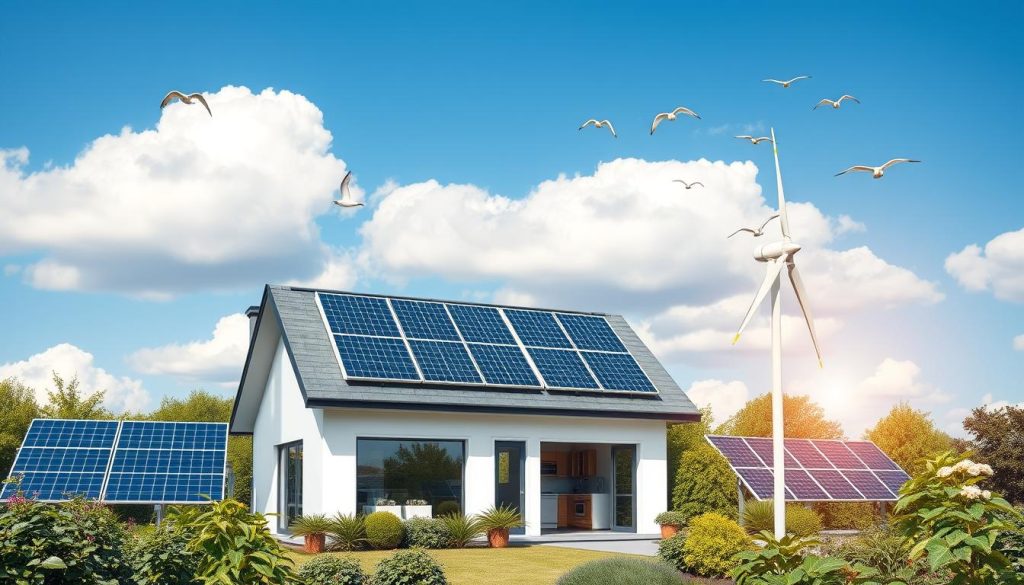
Also, governments and groups offer help and money for using renewable energy. These programs can make it cheaper to start using renewable energy. As we move towards renewable energy, it’s important to know about these chances.
| Renewable Energy Source | Benefits | Cost |
|---|---|---|
| Solar Panels | Lower energy bills, easy to keep up | $10,000 – $20,000 |
| Wind Turbines | Green energy, less carbon | $5,000 – $15,000 |
Knowing the good things and choices can help us switch to renewable energy. This makes our future better and greener.
Challenges and Solutions in Energy Transition
As we move to renewable energy, we face many challenges. These include needing more infrastructure, better ways to store energy, and making the grid work with new energy sources. To solve these problems, we need to find ways to integrate renewable energy into our systems.
One big issue is not having enough places to put new energy sources. We need to build more places for wind farms and solar panels. Also, we need to find ways to keep the energy flowing smoothly, like using batteries to store it.
Smart grids could be a big help. They can manage energy better and make sure it gets to where it’s needed. New tech has made storing energy cheaper and more efficient. This means we can use more renewable energy without problems.
| Challenge | Solution |
|---|---|
| Infrastructure requirements | Investment in renewable energy infrastructure |
| Energy storage solutions | Development of advanced battery technologies |
| Grid integration | Implementation of smart grid systems |
Infrastructure Requirements
We need more places for renewable energy like wind farms and solar panels. Governments and companies must invest in building these places.
Storage Solutions
Batteries are key for keeping the energy steady. New tech has made them better and cheaper, helping us store more energy.
Grid Integration
It’s important to make sure new energy sources work well with our grid. Smart grids can help manage this, making our energy system better and more reliable.
The Future of Energy Production
The future of energy is all about green sources. We’re moving away from old energy types. This shift is good for our planet and our future.
Studies show that green energy like solar and wind is getting cheaper. This makes it easier to use instead of old energy. New tech will help us store and use this energy better.
Looking ahead, green energy will lead the way. Experts say it will soon be the main energy source. With more work and new ideas, we can make our energy cleaner and greener.
| Energy Source | Current Capacity | Projected Growth |
|---|---|---|
| Solar | 700 GW | 15% per year |
| Wind | 600 GW | 10% per year |
| Hydro | 1,200 GW | 5% per year |
Many things will shape our energy future. Tech, money, and caring for our planet are key. We must focus on green energy to make our future brighter.
Conclusion
We’ve looked at the big difference between renewable and non-renewable energy. Renewable energy is key to a better future. It’s time to move away from old ways like fossil fuels and nuclear power.
The shift to renewable energy is happening fast. New tech and smart ideas are leading the way. Knowing the renewable and non-renewable energy contrasts helps us make better choices.
Together, we can make a big change. The difference between renewable and non-renewable energy affects our planet and our wallets. Renewable energy means a cleaner world and more jobs.
The journey is long, but we can do it. We just need to work together and keep going. Let’s keep learning and pushing for a greener tomorrow.
FAQ
What is the difference between renewable and non-renewable energy?
Renewable energy comes from nature and can be used over and over. Examples are solar, wind, and water power. Non-renewable energy, like oil and coal, runs out and can’t be made again.
What are some examples of renewable and non-renewable energy sources?
Renewable energy includes solar, wind, and water power. Non-renewable energy is oil, gas, and coal.
What are the advantages of renewable energy?
Renewable energy is good for the planet and doesn’t pollute. It also helps fight climate change. Plus, it can make us energy independent and create jobs.
How do the environmental impacts of renewable and non-renewable energy sources differ?
Renewable energy is kind to the planet. It doesn’t make harmful gases. But, getting non-renewable energy can hurt the environment a lot.
What are the economic implications of transitioning from non-renewable to renewable energy?
Switching to renewable energy costs more at first. But, it saves money in the long run. It also creates new jobs and helps the economy grow.
What are some of the challenges in transitioning to renewable energy?
Changing to renewable energy is hard. We need new power lines and ways to store energy. This is because some renewable energy, like sun and wind, isn’t always there.
What is the current state of renewable energy adoption globally?
More countries are using renewable energy. They want to use less non-renewable energy. But, it’s slow because of government rules, new tech, and public support.

